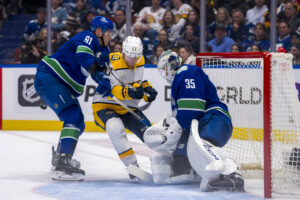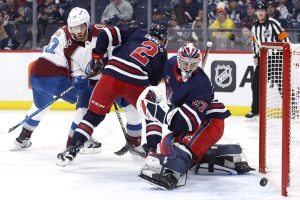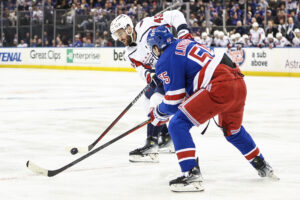Why would the Vancouver Canucks extend GM Jim Benning? It isn’t a huge surprise; the timing is interesting, though. Entering the final year of his contract, this season was expected to be his Make or Break year; make the playoffs or get fired. His recent moves reinforce this opinion – you don’t trade away a first-round pick expecting failure.
In the Ben-ginning
It’s still a bit early to evaluate his draft history, though it’s generally regarded positively by fans and media alike. Trades and free-agent signings, on the other hand, are usually for NHL players and provide more substance to judge. So focussing on those:
Benning was hired in 2014 as a choice of new team president Trevor Linden. The team had missed the playoffs for the first time in five years, resulting in a purge of coaches John Tortorella and Mike Sullivan and GM Mike Gillis.
But the team wasn’t a blank slate.
Start Over or Continue Pushing?
He was hired to return a team that was three years away from the Stanley Cup Finals to contention. This wouldn’t be easy, as the previous regime had traded away assets to build and maintain a competitive team. The first moves Benning made were to buy out an unproductive David Booth; hire the Calder winning coach Willie Desjardins, and deal with Ryan Kesler‘s trade request.
That last one had been an ongoing problem for the team, as Kesler used his no-move clause to limit trade partners. It was Southern California or nowhere. They received a surprisingly substantial return when a deal was finally reached with Anaheim. That same week, Benning brought in veteran goaltending in Ryan Miller, moved the diminishing Jason Garrison, and added firestarter Derek Dorsett. Before the season started, he added Radim Vrbata for depth scoring, avoided arbitration with Chris Tanev, and re-signed Zack Kassian.
During the season he also added current player Sven Baertschi, paying a second-round pick in the deal. This tells where the team was focussing. It was shaping up to be a successful year, so moving the pick for secondary scoring was unsurprising. Indeed, the Canucks returned to the playoffs, winning just two games in a first-round loss to the Calgary Flames.
The Dead Cat Bounce
That 101-point season, and failed playoff run coloured the following year’s moves.
Miller had shown he was still a very capable goaltender, and with two NHL-ready backups, Eddie Lack was moved out. Long-time defenceman Kevin Bieksa was also traded for a second-round pick – a pick that was integral to what came next. In one of GM Benning’s most controversial moves, Brandon Sutter was brought in to shelter sophomore centre Bo Horvat. He signed him to a five year deal with a $1 million raise and a no-trade clause before he had played a single game for the team.
It got worse when Sutter was injured that year, only managing 20 games. Horvat filled a top-six role earlier than expected.
Defenceman Frank Corrado was lost on waivers when the team chose to play Ben Hutton at the start of the season instead. There was a minor uproar about how Benning was managing assets. Fans believed that Corrado had decent trade value. Certainly more than nothing, at least. Veterans Linden Vey and Alex Biega were also sent to the minors, losing roster spots to rookie forwards Jared McCann and Jake Virtanen. Injuries would bring Vey and Biega back, but the team was clearly pushing youth this season.
The Canucks offense collapsed that year, scoring 51 fewer goals than previously, and the team managed just 75 points. Rookie Hunter Shinkaruk was traded for the versatile but older Markus Granlund to a little result that season. The trade improves in retrospect.
A Desperate Reach
Benning only made one major trade in the 2016 off-season (for the Canucks, anyway) but it was another controversial one. He brought in Erik Gudbranson and a fifth-round pick for Jared McCann, a second-round pick, and a fourth-round pick. On a team that desperately needed scoring, giving up a skilled young forward for a tough, hard-hitting defenceman was a shock.
That controversy would be shoved to the back pages less than two months later when Benning signed Loui Eriksson to a six-year, $36 million deal. It was a bonus-laden contract with no movement and no-trade clauses, necessary additions to win his services. The idea was to reunite him with fellow Swedes Henrik Sedin and Daniel Sedin, hoping to recreate what was a very effective line international play. That backfired when they couldn’t build on their prior chemistry, and Eriksson was moved down the lineup as the year progressed.
The Canucks had their worst offensive year in team history, managing just 182 goals and finishing the season with 69 points. Coach Desjardins was fired the day after the season ended. It was the first year neither Sedin led the team in scoring in a decade. During the season, long-time Canucks Alexandre Burrows and Jannik Hansen had been traded for Jonathan Dahlen and Nikolay Goldobin respectively.
Clearly, making moves to be competitive hadn’t worked, a revelation underscored by Benning’s Hail-Mary signing of Eriksson. It was time for a long-overdue rebuild. If this was the point whether the Canucks extend GM Benning or not, he likely wouldn’t have seen the next season, never mind possibly reaching 2023.
Reality Sets In
Benning made several signings in the free agency period going into the 2017-18 season, but none were as dramatic as previous years. He let Ryan Miller go, starting the year with a tandem of Jacob Markstrom and Anders Nilsson. Other players brought in were depth signings or wild cards, with the hope they would find previous levels of play. Or if not that, then provide some shelter for younger players making their way into the lineup.
It was another injury-ravaged season, unfortunately. Only three players made it past 75 games, and two of them were playing their last NHL games. Gudbranson signed a highly controversial three-year extension. Signee Thomas Vanek was traded away mid-season to get current Canuck Tyler Motte. Rookie Brock Boeser led the team in goals, despite missing 20 games. The team ended the year out of the playoffs again with 73 points.
But the big story was the retirement of Daniel and Henrik Sedin. It was a decision they kept from the league at large until the last week of the season. Both had good seasons to end their careers on, each hitting the 50-point mark. But it left Benning with considerable gaps to fill the following year.
Renew With The Old?
He did it by three more controversial free-agent signings; Jay Beagle and Antoine Roussel for four years each (with modified no-trade clauses) at $3 million per season and Tim Schaller for two. They were brought in to “toughen up” the team, increasing their physical presence. It makes for a very expensive bottom-six if that’s where they play.
The 2018-19 season has been about moving unused players and correcting past mistakes. Gudbranson, Dahlen, Nilsson, Sam Gagner, and Michael Del Zotto were all shipped out. Minor leaguer Michael Carcone was traded for NHLer Josh Leivo.
The biggest stumble for Benning this season was his unpreparedness for injuries to his goaltenders. He traded Nilsson, but the team was left scrambling when the returning goaltender was claimed off waivers. Michael DiPietro was called up from the OHL, getting into one game to give Markstrom a brief respite, and was shelled for seven goals behind a nervous team. Eventually, the lack of experienced goalies was solved by picking up Marek Mazanec for a draft pick, but it remains a mark against an unprepared management group.
It was an ultimately unsuccessful year, missing the playoffs once again, but there were positive signs as well. Benning’s draft picks were making themselves known. Pettersson winning the Calder; Virtanen rounding into form; Adam Gaudette getting his first goals as an NHL regular; and Guillaume Brisebois, Thatcher Demko, and the heavily-anticipated Quinn Hughes all making appearances late in the season.
Should the Canucks Have Extended GM Benning?
Are the Canucks in a better position now than they were when Benning was hired in 2014? That team he inherited had some better players, certainly. But they were aging and had spent the previous years pushing for a Stanley Cup win – and nearly made it. The current version is one that spent several years near the bottom of the standings for the past four years. But the best players are also their youngest, and they still have some good prospects on the way.
Having a stable group in management helps a team maintain focus. Keeping people in place for another four years means there won’t be a sudden change of direction. That lets what’s been happening so far continue on schedule. There have obviously been mistakes and missteps along the way. But the past five years have had two different objectives. What year should we say the current rebuild actually started?
Rebuilding teams do it primarily through the draft. Realistically, it will take years before the rebuilding GM’s impact will be really felt. Are those players entering the league now? They’ll be coming into their prime, and Benning deserves to be around to see it.






